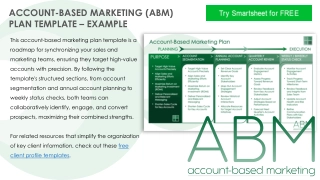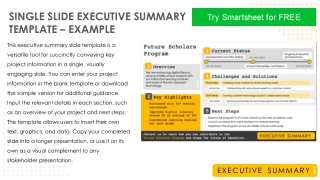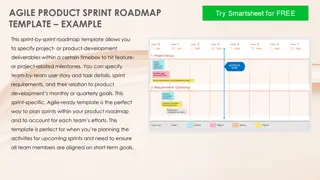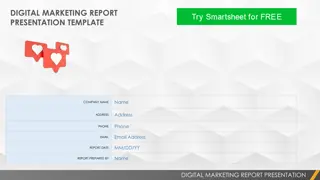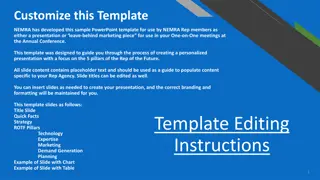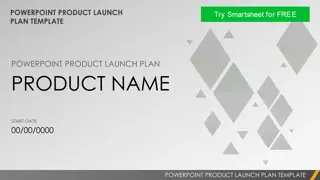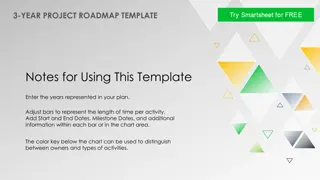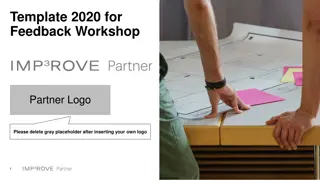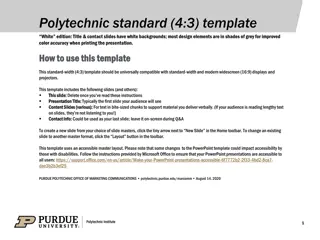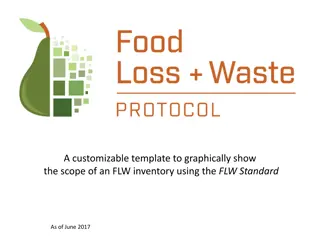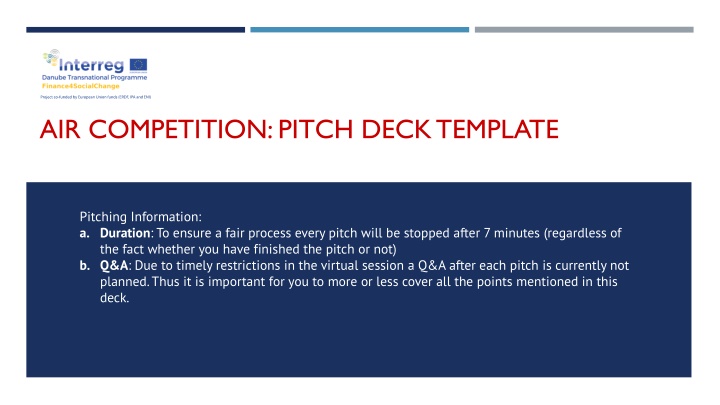
Crafting an Impactful Pitch Deck for Air Competition
Elevate your pitch presentations with this comprehensive pitch deck template for air competitions. Learn key tips on slide design, content structuring, and essential information to cover within a limited time frame. Impress investors with a professional and well-organized pitch.
Download Presentation

Please find below an Image/Link to download the presentation.
The content on the website is provided AS IS for your information and personal use only. It may not be sold, licensed, or shared on other websites without obtaining consent from the author. If you encounter any issues during the download, it is possible that the publisher has removed the file from their server.
You are allowed to download the files provided on this website for personal or commercial use, subject to the condition that they are used lawfully. All files are the property of their respective owners.
The content on the website is provided AS IS for your information and personal use only. It may not be sold, licensed, or shared on other websites without obtaining consent from the author.
E N D
Presentation Transcript
AIR COMPETITION: PITCH DECK TEMPLATE Pitching Information: a. Duration: To ensure a fair process every pitch will be stopped after 7 minutes (regardless of the fact whether you have finished the pitch or not) b. Q&A: Due to timely restrictions in the virtual session a Q&A after each pitch is currently not planned. Thus it is important for you to more or less cover all the points mentioned in this deck.
THE MASTER SLIDE a. Include your logo in the master slide so that it shows up on all your slides in the exact same place. The logo is most commonly placed in the top right corner. b. Use slide colours matching your company colours/logo. c. Do not forget page/slide numbers! This is a pet peeve for most investors. Use auto generated slide numbers, not ones you have to add manually. These are best placed at the bottom left corner. 2
SLIDE 0: THE TITLE SLIDE a. Company name with logo: Investors like to see the registered name of the company (if you have one). If you want to be known by a brand rather than your registered company name, then include your brand as the main name, and the registered name of your company under it. b. Contact details: Many entrepreneurs leave this for the last slide, but most investors don t even reach the last slide while looking through your deck, so it is best to have contact details on both the first and last slides. Include your name, email address, and website URL. Basically, you want to make it as easy as possible for the investor to reach you. c. Date: Your deck will change with time, so you have to make sure to version it. That doesn t mean adding v1, v2 in the file name, which looks extremely tacky. This also doesn t indicate any actual timeline. Add a date in the first and last slide, and keep it in the MMYY format. 3
SLIDE 1: PROBLEM STATEMENT AND IMPACT POTENTIAL Problems: Here is where you talk about the social / ecological problem that you re turning into an opportunity and designing a solution for. 1. Explain the nature of the problem and quantify it (how many people affected, what is amount of crop wastage, etc.). 2. What is the potential market size in your country and globally? 3. Use charts/statistics/pictures. 4. Optional: Briefly mention one or two main solutions already there in the market (if at all), and why newer solutions are needed. 4
SLIDE 2: SOLUTION A slide summarising your innovative solution to the above problem: a. Products: Describe your main products including their purpose and pricing. Show pictures of your products. What stage is the product in: R&D or prototype or clinical testing or commercial rollout already done. Mention any patents that you have or intend to file. b. Services: If you re a service business, describe your offering including your distribution model (how your offering reaches your customers). What stage is your service in: pilot planned or successful pilot complete or already generating revenue. Show pictures from the field. 5
SLIDE 3: BUSINESS MODEL This is an extremely important slide, which can make or break your case. Revenue streams: Businesses often have two to three diversified revenue streams. This is generally a positive, but make sure you re not doing too many things that require different skillsets early on in your business. Cost structure: Highlight your main costs COGS, manpower, sales, marketing, business development, R&D, etc. 6
SLIDE 4: COMPETITION Competition: If there are many players in the market offering similar products/services as you, create a this separate slide to detail how you are different/superior. For example: You can create a table with the main features to show how you shine against them. 7
SLIDE 5: PROGRESS THUS FAR Execution (pricing, distribution, financing) is often the main risk in social enterprises, so the more you ve already implemented on the ground, the better. Use this slide to show how far you ve come, perhaps without much marketing budget. Cover some of the following: a. Pilots done/milestones achieved. b. Progress made on product development if any. c. Number of customers served till date/products sold till date. d. Key clients serviced/partnerships forged e. Pictures of operations/camps, etc. f. Hiring progress (team size). 8
SLIDE 6: SOCIAL ADDED VALUE/IMPACT Here is the place where you talk about the social/ ecological impact that you are creating through your activities. a. What is the impact logic (Phineo result staircase or IOOI method)? b. What are your impact goals? Be precise and thereby give a good idea of your planned scale right up front. Make sure this number looks plausible and is not insanely large. 9
SLIDE 7: STRONG MANAGEMENT AND ADVISORY TEAM Many entrepreneurs like to have the team profiles come right upfront in the presentation, which is totally fine. We recommend it coming at this juncture right before going into your asks from the investor. a. Core management team profiles (in bullet format): Add picture of each team member. Name, designation, role in the company. Previous work experience number of years + main companies worked at. Educational qualifications. b. Current team size and future hiring expectations. c. Advisory team names and roles. 10
SLIDE 8: SCALE UP PLAN This is where you put your vision and mission into tangible metrics. How do you plan to scale the company in a one-year, three-year, and five-year timeframe? a. Expansion of service/product offerings. b. Include graphs of operational growth and financial growth. For example, number of centres, revenue growth, EBITDA growth highlighting breakeven point, etc. c. Maps for geographical expansion look good. 11
SLIDE 9: FINANCIALS a. These should reflect the above scale up plan. b. Profit & Loss statement for the last and three to five years ahead including main operational assumptions (example: number of centres launched), revenue lines, total revenue, COGS, gross profit %, main cost heads, EBITDA %. This should also show when the business as a whole will break even. 12
SLIDE 10: THE ASK a. How much total capital from which source has gone into the business. b. Funding requirement and use of funds. This will also determine what kind of capital you need to raise (equity or debt or other instruments). 13
OPTIONAL SLIDE: CHALLENGES/RISK AND MITIGATIONS This can be an important slide that some investors want to see. While you re obviously selling your and the company s story, it is important to show investors that you re realistic about the on- ground situation, you realise what the risks and challenges are, and you ve thought about how to mitigate them. a. Mention four to five biggest micro and macro risks. For example, lack of financing partners for your product, or regulatory landscape (be specific). b. We recommend using a tabular format with the challenges/risks on one side, and your idea for mitigating/hedging against them on the other. 14
SLIDE 11: THANKYOU a. A call to action sentence is a great way to wrap up your presentation. For example, Support us to educate 100,000 low income students in the next five years. b. Same contact details as Slide 0. 15

